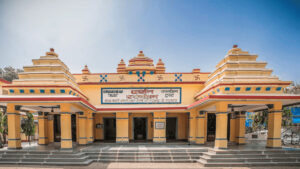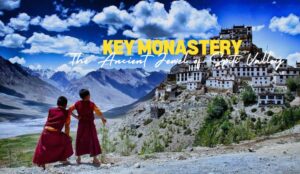Imagine embarking on a journey through the majestic Himalayas, where ancient temples, breathtaking landscapes, and a profound sense of spirituality await you at every turn. Welcome to the Chardham Yatra, a pilgrimage that captures the essence of Hindu devotion and the beauty of nature in the Indian state of Uttarakhand. This comprehensive guide will walk you through every aspect of this sacred journey, from its historical significance to practical travel tips.
What is Chardham Yatra?
Chardham Yatra is a revered pilgrimage circuit in Uttarakhand, encompassing four sacred sites: Yamunotri, Gangotri, Kedarnath, and Badrinath. These sites are collectively known as the “Chota Char Dham” to distinguish them from the larger Char Dham circuit in India. Devotees believe that undertaking this yatra (journey) washes away sins and leads to moksha (liberation).
Historical Significance
The origins of the Chardham Yatra date back to ancient Hindu scriptures and texts. It is believed that the great philosopher and reformer Adi Shankaracharya established the Char Dham to promote Hinduism and its spiritual teachings. These temples have been pilgrimage destinations for centuries, drawing devotees from all corners of the world.
Yamunotri: The Source of Yamuna River
Yamunotri is the starting point of the Chardham Yatra, nestled in the western Garhwal Himalayas. This site is dedicated to Goddess Yamuna, and it is home to the Yamunotri Temple, perched at an altitude of 3,293 meters. The temple’s sacred hot springs and the stunning backdrop of the Bandarpunch Peak make it a serene place for worship.
Yamunotri Temple: The central shrine dedicated to Goddess Yamuna, perched at an altitude of 3,293 meters. The temple is surrounded by picturesque views of the Bandarpunch Peak and other Himalayan ranges. The temple’s architecture and its serene setting contribute to its spiritual aura.
Surya Kund: It is a prominent hot spring located near the Yamunotri Temple. Pilgrims often cook rice and potatoes in the hot spring as an offering to the deity. This practice adds a unique element to the pilgrimage experience and provides a tactile connection to the sacred.
Divya Shila: A sacred rock pillar located near the temple, that is worshipped by pilgrims before they enter the main shrine. It is believed to hold divine energy and is an essential part of the ritualistic practices at Yamunotri.
Gangotri: The Origin of the Ganges
Gangotri, the second dham, is the source of the holy Ganges River. The Gangotri Temple, located at an altitude of 3,100 meters, is dedicated to Goddess Ganga. According to legend, King Bhagirath performed rigorous penance here to bring the river Ganga down from heaven to earth.
Gangotri Temple: This ancient temple, dedicated to Goddess Ganga, is a focal point of devotion for pilgrims. The temple’s structure, adorned with intricate carvings and a vibrant atmosphere, reflects the reverence associated with the Ganges.
Bhagirath Shila: A revered rock where King Bhagirath is believed to have meditated to bring the Ganges from heaven to Earth. This site holds immense historical and spiritual significance and is a place of deep contemplation for many pilgrims.
Gaumukh Glacier: Located approximately 18 kilometers from Gangotri, Gaumukh Glacier is considered the true source of the Ganges. The glacier, with its awe-inspiring ice formations and breathtaking surroundings, adds a sense of majesty to the pilgrimage.
Kedarnath: The Abode of Lord Shiva
Kedarnath, the third dham, is one of the twelve Jyotirlingas of Lord Shiva. Situated at an elevation of 3,583 meters, the Kedarnath Temple is surrounded by snow-capped peaks and the Mandakini River. The temple’s history dates back to the Mahabharata, and it is believed that Pandavas built the original temple.
Kedarnath Temple: An ancient shrine dedicated to Lord Shiva, the Kedarnath Temple is a revered site for devotees. The temple’s remote location and dramatic setting make it a powerful place for meditation and worship.
Shankaracharya Samadhi: The final resting place of Adi Shankaracharya, who is credited with reviving the importance of the Char Dham pilgrimage. This site, located near the Kedarnath Temple, is a place of reverence and respect for many pilgrims.
Vasuki Tal: A high-altitude lake situated about 8 kilometers from Kedarnath. The lake’s serene beauty and the trek to reach it provide a sense of tranquility and connection to the divine.
Badrinath: The Seat of Lord Vishnu
Badrinath, the final dham, is dedicated to Lord Vishnu. It is located at an altitude of 3,133 meters, between the Nar and Narayan mountain ranges. The Badrinath Temple is one of the holiest temples in Hinduism and a part of both the Chota Char Dham and the larger Char Dham circuit.
Badrinath Temple: The principal shrine dedicated to Lord Vishnu, the Badrinath Temple is known for its grand architecture and sacred atmosphere. The temple’s idol of Lord Vishnu, adorned with precious ornaments, is a focal point of devotion for pilgrims.
Tapt Kund: A natural hot spring located near the Badrinath Temple. Pilgrims bathe in the thermal waters to purify themselves before entering the temple. The Tapt Kund is considered sacred and adds a sensory dimension to the pilgrimage experience.
Neelkanth Peak: A majestic peak that provides a stunning backdrop to the Badrinath Temple. The peak’s towering presence and the surrounding landscape enhance the site’s spiritual significance and offer breathtaking views.
Preparing for the Journey
Best Time to Visit
The ideal time to undertake the Chardham Yatra is from late April to early November. The temples remain open during this period, and the weather is relatively pleasant. However, the peak season is May to June and September to October, when the weather is most favorable.
Physical and Mental Preparation
Embarking on the Chardham Yatra requires a certain level of physical fitness due to the high altitudes and challenging terrain. It is advisable to start preparing a few months in advance with regular exercise, including walking, jogging, and yoga. Mental preparation is equally important, as the journey is not just a physical trek but also a spiritual quest.
Packing Essentials
When packing for the Chardham Yatra, it’s crucial to be well-prepared for varying weather conditions. Here’s a list of essentials:
- Warm clothing: Thermal wear, jackets, and woolen accessories.
- Comfortable trekking shoes: Sturdy and waterproof.
- Personal medications: Including altitude sickness tablets.
- Travel documents: ID proofs, permits, and itinerary.
- Other essentials: Sunscreen, sunglasses, toiletries, and reusable water bottles.
The Spiritual Atmosphere
From the moment you set foot on the path to each dham, you are enveloped in a profound spiritual ambiance. The chants of hymns, the fragrance of incense, and the sight of devout pilgrims create an atmosphere of devotion and reverence. Each temple offers a unique spiritual experience, reinforcing the faith and beliefs of the pilgrims.
The Natural Beauty
The journey through the Himalayas is not just a spiritual one but also a visual treat. The towering peaks, lush valleys, and pristine rivers make the Chardham Yatra a feast for the eyes. Whether it’s the serene banks of the Yamuna, the majestic glaciers of Gangotri, the rugged terrain of Kedarnath, or the tranquil surroundings of Badrinath, every step of the way is filled with natural wonders.
Challenges and Rewards
The Physical Challenges
The Chardham Yatra is not without its challenges. The high altitudes can lead to altitude sickness, and the steep paths require considerable stamina and endurance. Weather conditions can be unpredictable, with sudden rain or snow making the journey even more challenging. However, the sense of accomplishment and spiritual fulfillment upon reaching each dham outweighs these difficulties.
The Spiritual Rewards
The spiritual rewards of the Chardham Yatra are immense. Pilgrims often describe a deep sense of peace, clarity, and connection with the divine. The act of undertaking this sacred journey is seen as an offering of devotion and penance, bringing them closer to moksha. The collective experience of devotion, prayer, and community creates a powerful spiritual synergy that is deeply enriching.
Chardham Yatra Packages
For those looking for a well-organized and hassle-free experience, WanderSky offers a range of Chardham Yatra packages designed to cater to various needs and preferences. Their packages include comprehensive travel arrangements, accommodation, and guided tours to ensure a seamless pilgrimage experience. Whether you’re interested in a luxury package with comfortable stays and private transportation or a more budget-friendly option with shared accommodations and group tours.
WanderSky provides customized solutions to suit your requirements. Their expert guides and support staff help pilgrims navigate the challenging terrain, handle permits, and offer valuable insights into the spiritual significance of each site. Choosing a WanderSky package can enhance your Chardham Yatra, making it a memorable and enriching journey.
Practical Tips for Pilgrims
Travel Arrangements
Transportation: Plan your transportation well in advance. Options include hiring private vehicles, using public buses, or joining organized tours. Helicopter services are also available for a quicker and more comfortable journey.
Accommodation: There are various accommodation options ranging from budget guesthouses to more comfortable hotels. It is advisable to book in advance, especially during peak seasons.
Permits and Registrations: Ensure you have all necessary permits and registrations. The government requires biometric registration for the Chardham Yatra, which can be done online or at designated centers.
Health and Safety
Acclimatization: Spend a day or two at a lower altitude before heading to higher regions to acclimatize your body.
Hydration: Stay hydrated to avoid altitude sickness. Drink plenty of water and avoid alcohol and caffeine.
Medical Assistance: Keep a list of medical facilities en route and carry a basic first aid kit. Be aware of the symptoms of altitude sickness and seek medical help if needed.
Conclusion
The Chardham Yatra is a journey of faith, devotion, and self-discovery. It is a testament to the enduring power of spirituality and the human spirit. Whether you are seeking divine blessings, spiritual growth, or simply an adventure in the Himalayas, the Chardham Yatra offers a transformative experience that stays with you long after you return. So, pack your bags, prepare your heart, and set forth on this sacred journey that promises to be a once-in-a-lifetime experience.
FAQs About Chardham Yatra
1. When is the best time to undertake the Chardham Yatra?
The best time to undertake the Chardham Yatra is from late April to early November, with peak seasons being May to June and September to October.
2. How can I prepare physically for the Chardham Yatra?
Start preparing a few months in advance with regular exercise, including walking, jogging, and yoga. Building endurance and strength is key, as well as practicing breathing exercises to help with high altitudes.
3. What are the essential items to pack for the Chardham Yatra?
Essential items include warm clothing, comfortable trekking shoes, personal medications, travel documents, sunscreen, sunglasses, toiletries, and reusable water bottles.
4. Are there any health risks associated with the Chardham Yatra?
Yes, the primary health risk is altitude sickness due to high altitudes. Symptoms include headaches, nausea, and dizziness. It’s important to acclimatize, stay hydrated, and seek medical help if necessary.
5. What accommodation options are available during the Yatra?
Accommodation ranges from budget guesthouses to more comfortable hotels. It is advisable to book in advance, especially during peak seasons, and consider staying in government-run rest houses for reliability.
6. Can I undertake the Chardham Yatra alone, or should I join a group?
While it is possible to undertake the Yatra alone, joining a group or organized tour can provide additional safety, support, and convenience, especially for first-time pilgrims





